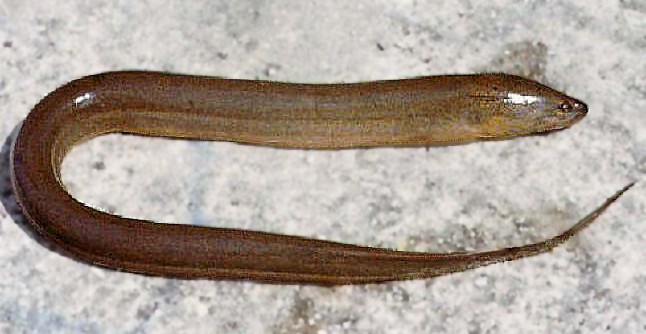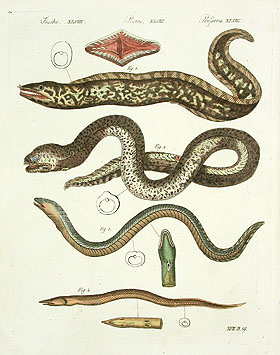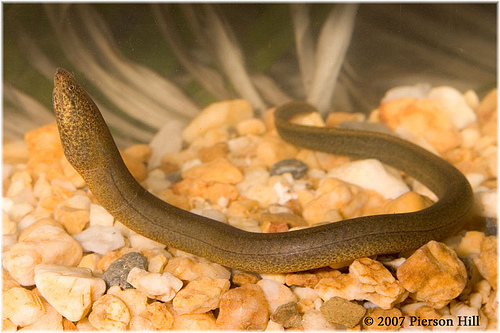
Synbranchus marmoratus
FAMILY
Synbranchidae
TAXONOMY
Synbranchus marmoratus Bloch, 1795, Rio Negro, Brazil.
OTHER COMMON NAMES
English: Swamp eel; French: Anguille; German: Amerikanischer;
Spanish: Anguila.
PHYSICAL CHARACTERISTICS
Grows to 50.1 in (150 cm). It has a long and cylindrical body,
lacking pectoral and ventral fins and with vestigial dorsal and
anal fins. The species has small eyes.
DISTRIBUTION
From Mexico to Central Argentina.
HABITAT
This species inhabits fresh and brackish waters in a variety of
habitats, including streams, canals, drains, ponds, and rice
fields. It can be seen in both clear and murky waters.
BEHAVIOR
This is a nocturnal fish usually found at the edge of the water.
It can travel over land for considerable distances. It also burrows,
especially during the dry season. During that time its
metabolism is reduced considerably, but it still may flee if disturbed.
After the first rains, it returns to larger bodies of water.
FEEDING ECOLOGY AND DIET
They feed on fish and invertebrates and are considered aggressive
predators. They are vulnerable to crocodilians and fisheating
birds.
REPRODUCTIVE BIOLOGY
This is a species characterized by two unusual reproductive
methods. In the first, many individuals undergo sequential hermaphroditism,
where some fish function first as females and
then as males, called terminal males. This condition is called
protogy, and species that have such individuals are called protogynous.
Those individuals that are males from the beginning
are called primary males. Some individuals remain juvenile females,
a condition termed diandric. They have external fertilization
and show some level of genetic variability, which is
consistent with the fact that this is a generalist species with a
broad
DISTRIBUTION
in the New World. No specific seasonal reproductive
data or parental care information has been published.
CONSERVATION STATUS
Because of its broad
DISTRIBUTION
, it is not considered threatened.
Owing to its burrowing
BEHAVIOR
, however, it may be
missed in many faunal surveys.
SIGNIFICANCE TO HUMANS
Is not infrequent in public aquaria although it does not make a
good exhibit because of its burrowing
BEHAVIOR
. Because of its
size it is difficult to keep in home aquaria.
Other popular Animals
Photo Gallery of - Marbled swamp eel





 Animalia Life
Animalia Life